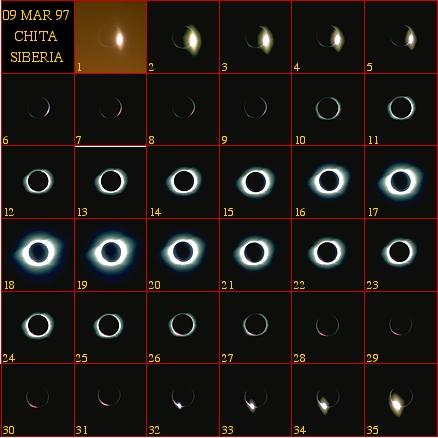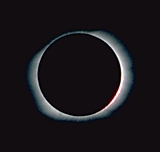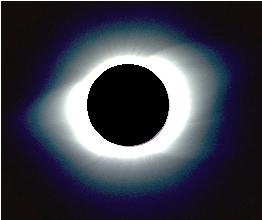09 March 1997 Chita, Siberia,
Russia
... with just the
shirt on my
back.

The above pair of images are composites (made from several of the
individual frames shown below) have been prepared using subtly
different linearity transformations and color mappings. The image
on the right has been intentionally very slightly geometrically
distorted (rotationally "skewed" about the center). WHY?
The images are presented to be viewed as you would a "left/right"
stereogram to give the impression of both (a small) enhancement in
detail of the coronal structure, and a modest pseudo-3D appearance in
the "fused" image. Viewing L/R stereograms is difficult (if not
impossible) for some people, but easy for other with some
practice. Some tips on viewing L/R stereograms are HERE (and
another example is HERE), but
do be sure to keep your head level, and take your time for your eyes to
adjust to relax into "afocal" imaging. Compare that to viewing
just the frame on the left, which is reproduced HERE
at twice the image scale. What do YOU think?
On March 7, 1997, I began a just under 4-day
round-trip
nearly sleepless sojourn originating in Baltimore to stand for 1
minute and 53.2 seconds on a hilltop in north-central Siberia wearing
only
a light set of travel clothes to fend off the Russian winter
chill.
You see, the total solar eclipse of 09 March 1997 occurred during one
of
the busiest times of my life. Just a few weeks earlier we had
successfully
installed the Near Infrared
Camera
and Multi-Object Spectrometer into the Hubble Space Telescope
during
the second HST Servicing mission. As the NICMOS Project
Instrument
Scientist (what
I do in real life, when not chasing eclipses) I was deep in the
middle
of the early commissioning of the instrument during the Servicing
Mission
Observatory Verification phase of the program. In fact, the
eclipse
occurred between the first two iterations of our coarse optical focus
and
alignment runs which, by a miracle, were spaced 6 days apart, equally
straddling
the eclipse. This gave me just enough time to download the
initial
set of imaging and engineering data into my laptop to analyze during
the
long series of airplane flights to and from Siberia and to return just
in time for the real-time uplinks to the spacecraft to adjust our focus
and alignment optics. It was somewhat ironic that the same laptop
computer which was being used to ascertain the best optical alignment
for
a $106,000,000 instrument on what arguably might be the most complex
telescope
ever built would contemporaneously be used to control a camera propped
up on a rock in the Siberian hills.
Because my time was so limited I was traveling
"light"
and had planned only on watching the eclipse with 7x50 binoculars while
carrying out an automated photographic program with a modest 400mm lens
on a camera controlled by UMBRAPHILE.
I had everything I needed to photograph and watch the eclipse in my
hand-carry,
except the camera tripod which had been checked as luggage in my one
suitcase
which also had my heavy winter clothes. To shorten an
interminably
long story my baggage had gotten waylaid at Heathrow. Because I was
going
straight from London to Moscow to Irkutsk to Chita without stopping,
except
to wait in airline terminals, there was no way for my errant suitcase
to
reach me before I returned to Moscow on the way home. The thought
of spending 4 days in the same set of clothes - and not having any warm
clothes on eclipse morning - was less troubling to me than the loss of
my tripod, until the sub-Arctic chill hit me in Chita.
Fortunately,
after meeting up with Steve Kolodney, an eclipse-chasing compatriot
from
California, he took pity on me and I did end up with more than just the
shirt on my back. Thanks, Steve.
The loss of the tripod was another matter. As
I
was arriving in Chita the evening before the eclipse, and the fact that
it was "Women's Day" and all of the stores were closed, precluded any
possibility
of purchasing one if one could be found. The good thing about
using
a modest photographic set-up is that it is amenable to
flexibility.
Since totality was only 1m 53.2s in duration, with the Sun not very
high
in the sky, I was literally able to prop the camera up on a pile of
well
placed rocks, and simply let the sun drift 1/2 degree through the
7.5-degree
field of view during totality. Despite an agonizing morning, one
in which we came within a hairs breath of hopping on a Russian
equivalent
of a 737 to get above the threatening clouds, we elected to locate
north
of centerline where the weather looked more promising. The
weather
spirits cooperated and I had a spectacular view of my 19th total solar
eclipse from Latitude = 52D 17.558N, Longitude = 104D 16.834'E,
Altitude
= 2722ft. Even the pictures came out reasonably well. In
1991
the ancestral prototype to my UMBRAPHILE controller, ROSE,
flipped out in the > 100 degree F heat of the Mexican sand.
That
problem was remedied (fortunately) in time for the eclipse, but I had
prepared
not to repeat that in reverse. The self-heating "gel packs" which were
taped to my PowerBook did well to keep it warm and happy throughout the
eclipse, though I never thought to use one to keep my hands warm (see
footnote
accompanying the montage of photographs below). There is a lot
more
to tell of this story, but as time is again limited, for now here are
some
of those photographs until time permits a more detailed retelling of
the
events.
TOTALITY: Automated
Imaging
Sequence
Low Resolution Scans

The total solar
eclipse of 9
March 1997 was photographed using Kodachrome-64 film and a 400mm
f/5.6 lens (refractive optics) on a Nikon EM camera controlled by the
UMBRAPHILE
automated eclipse photography program. Diamond-ring exposures
(#'s
1-5) on 1-second spacings were 0.01s in duration.
Subsequent
exposures through mid-eclipse (to exposure 18) were ramped up
logarithmically
in increasing duration to 1.5s, and the sequence was inverted through
third-contact
and the subsequent diamond ring.
What happend to exposures
1 and
36? My hands were numb from the cold when I loaded the camera
and,
unknowingly at the time, used more film as leader than intended.
As a result I obtained only 35 images instead of the planned 36 and the
first one was corrupted by having been accidentally exposed to abient
light.
As you can see this, fortunately, was not really a problem. It is
a good thing UMBRAPHILE was operating my camera for me, since my
fingers
were just too cold to have worked it myself!
|
A Few Medium
Resolution Scans
from the Above Sequence

Frame #10
|

Frame #18
|

Frame #26
|
Take me to Glenn
Schneider's Home Page (and an index to other eclipse summaries).
Tell me more about automated eclipse photography withUMBRAPHILE.
